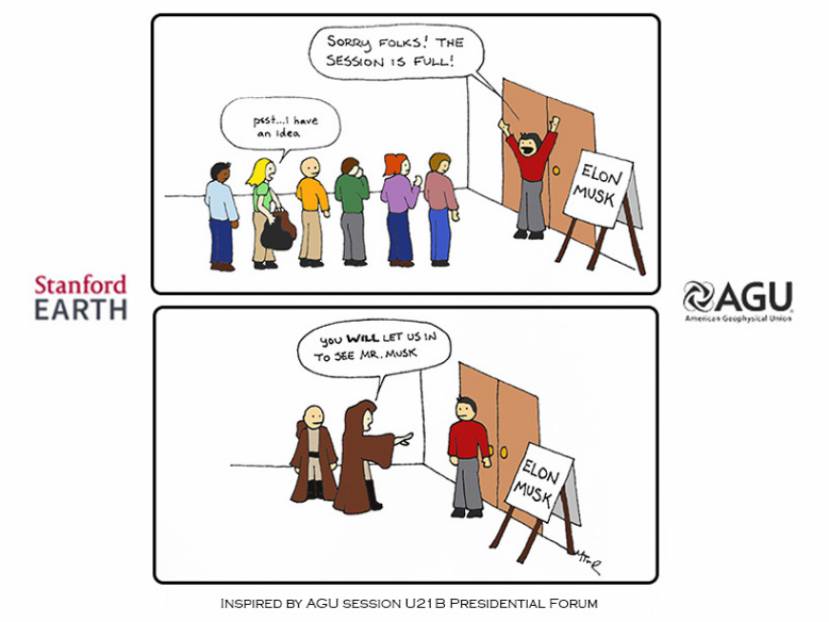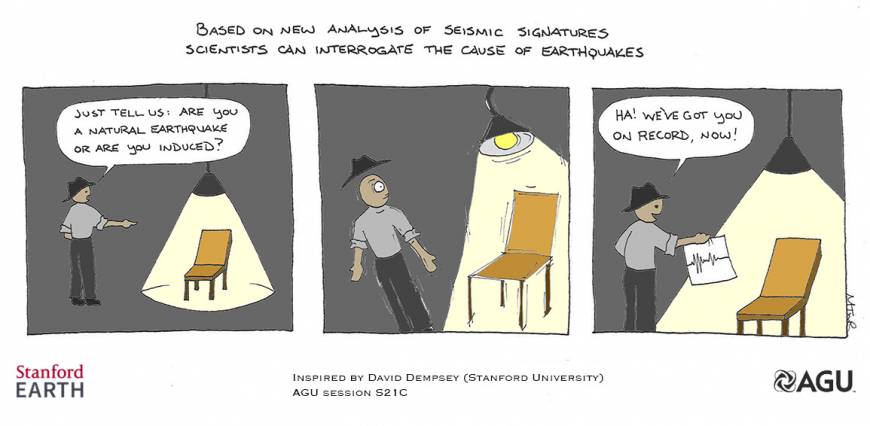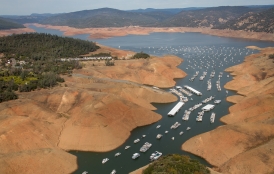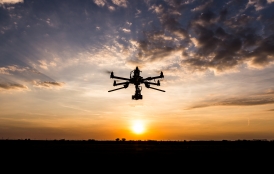The Stanford School of Earth, Energy & Environmental Sciences is now part of the Stanford Doerr School of Sustainability.
This page is currently being maintained for archival purposes only. For the latest information, please visit us here.
Earth and space science, in cartoons!
Stanford Earth’s multimedia producer Miles Traer captures the latest scientific discoveries presented at the American Geophysical Union’s Fall Meeting in this ongoing series of cartoons drawn live from the event.
By
Miles Traer
<p>Stanford School of Earth, Energy & Environmental Sciences</p>
December 17, 2015
Kate Wheeling
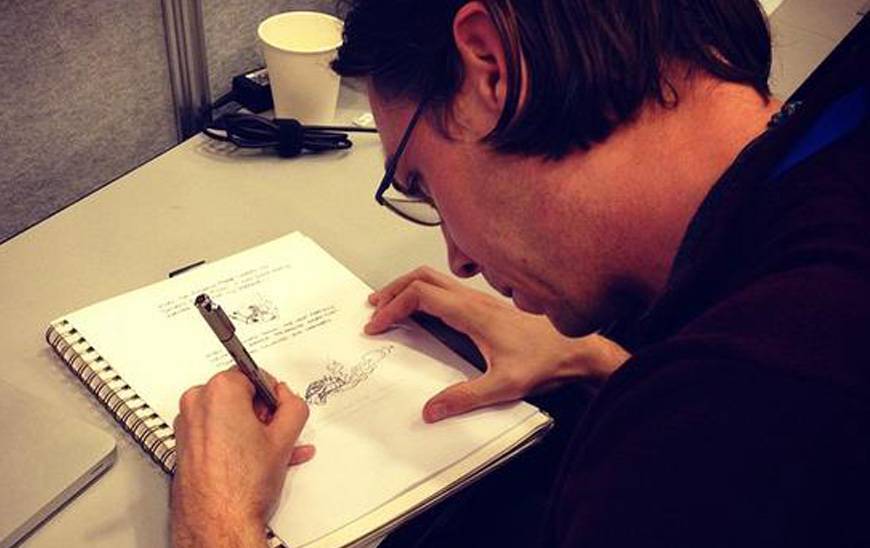
Every year, tens of thousands of Earth and space scientists converge on San Francisco to present their latest research discoveries at the American Geophysical Union’s (AGU’s) Fall Meeting, the largest gathering of its kind. The hallways buzz with electric conversations, people stand in long lines to listen to world-renowned speakers, and some even dress up to celebrate the occasion. Attending scientists have even referred to the AGU Fall Meeting as “Comic-Con for geologists.”
My name is Miles Traer, and I am an Earth scientist and cartoonist. From December 14-18, 2015 I will be drawing cartoons live from the floor of AGU, inspired by the work presented across a huge range of disciplines. New cartoons will be posted every day so check back in for updates about Earth, space, exploration, peculiar observations, fantastic theories, and lava-powered musical instruments.
Monday
Every year I try to prepare for AGU, and every year this happens.
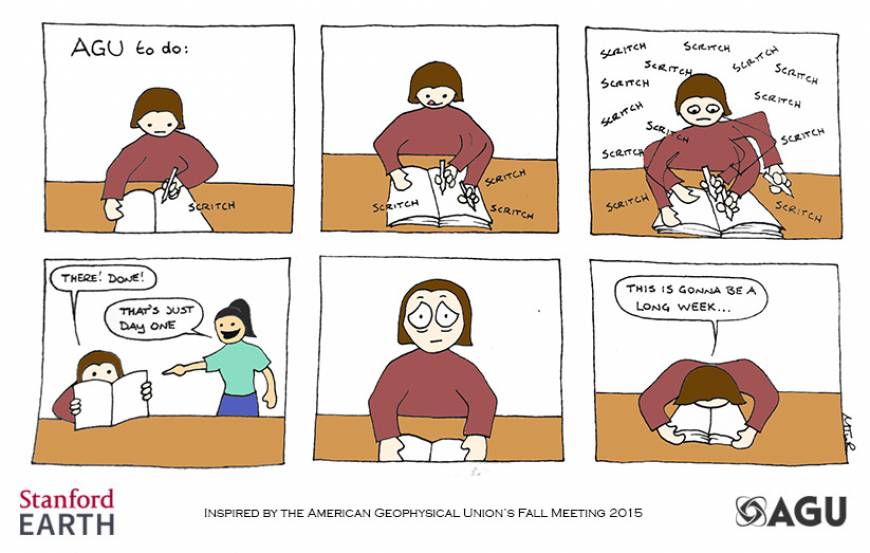
AGU often showcases the amazing work being done at the intersection of technology, Earth science, and space. Our own Howard Zebker has been involved with the Cassini Mission to Saturn for many years, using sophisticated instruments to probe the planet and its moons. Titan, the largest of Saturn's moons, has been a focal point in recent years. And now, there's more reason than ever to pay attention to what's going on down on the surface.

After listening to many presentations about space exploration, I realized that many of the satellites and rovers space engineers have made seem to last much longer than predicted. This got me thinking about these incredible feats of engineering and the people who make them.

Taking a break from the space-related sessions, I turned back to Earth and the energy systems we use. Professor Sally Benson discusses how to deal with gas leaks, especially at abandoned wells or those caused by faults and fractures. She mentioned that fixing these leaks isn't always straightforward... but I can think of one comical company that would beg to differ.

After pondering how one might use corks to plug gas leaks, I returned to space (figuratively) and learned about the latest results from NASA's MAVEN mission to Mars, designed to study the planet's upper atmosphere and ionosphere. Jane Fox, one of the mission scientists, had a curious observation about the first dataset she got back.

Tuesday
This morning is AGU's Presidential Forum featuring Elon Musk. Among his many tremendous technological accomplishments, Mr. Musk's company, Tesla Motors, developed the Model-S, the most successful fully electric car ever built. The car represent a complex feat of engineering, and I was reminded of a cartoon drawn by Randall Munroe for his webcomic xkcd. Here is the Tesla Model-S explained using only the 1,000 most commonly used words in the English language.

This year, AGU's Fall Meeting coincides with the release of the latest Star Wars film, and many of the scientists I've spoken to point to Star Wars as an inspiration to learn science. With Pay Pal, Tesla Motors, Solar City, and Space X, Elon Musk seems to exist in a world where science fiction is rapidly becoming science reality. When those two powerhouses - Star Wars and Elon Musk - collide, strange things happen.
AGU always serves as one of the premier places to discuss geology and geophysics. Stanford Earth graduate student David Dempsey and professor Jenny Suckale presented their latest work analyzing seismic signatures from induced earthquakes.
Wednesday
Stanford Earth's George Hilley has developed an app that creates digital field-trip experiences for its users. But what truly distinguishes his app is the fact that it learns what you know based on previous experiences, and it is therefore able to tailor your field-trip specifically to you. A self-learning computer-based program that's designed to help us... I think I've seen that movie.

Climate change is most often associated with rising temperatures. But Earth's recent past experienced a prolonged cool period that scientists refer to as "the little ice age." New work presented by Kaustubh Thirumalai suggests that when thinking about today's climate change, looking to the little ice age might be just as helpful as looking to other periods that were considerably warmer. I wonder what would happen if medieval scientists had access to this information.

My PhD research was done with professor George Hilley in geomorphology - the field of science that explains the forces that shape the world around us. From badlands to deserts to mesas to mountains, the world takes very different shapes depending on where you are. Some scientists are currently searching for what they call "the grand unified theory of hillslopes." And when I think of hillslopes, I am always reminded of my favorite comic strip from when I was a child.

Thursday
Thursday is shaping up to be a space-heavy day, with new announcements from Pluto and the drawf planet, Ceres. Ceres is an interesting little place, with bright spots that scientists are working hard to explain, and an overall shape that is eerily reminiscent of something.
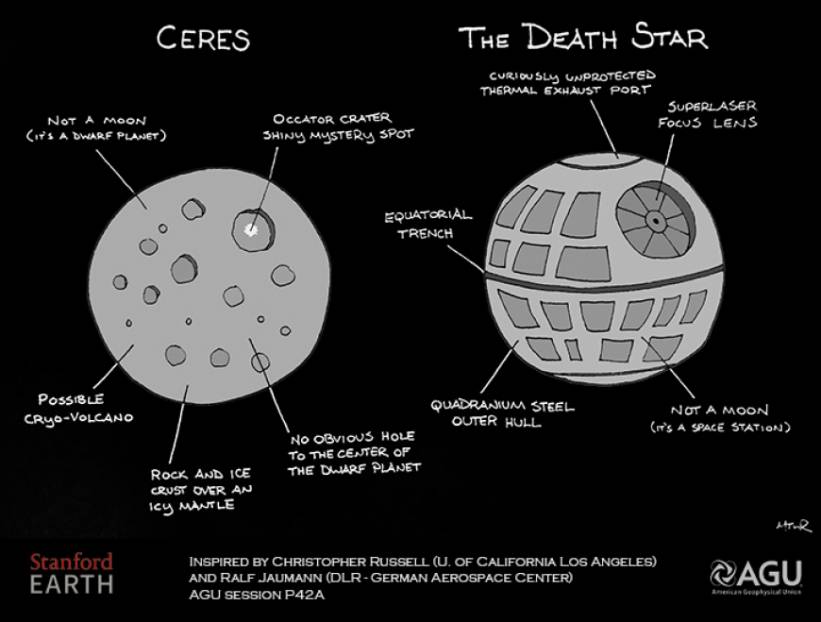
Latest update from Pluto's Sputnik Planum region suggests that there may be icebergs there. Space luxury liners beware.

Work from former Stanford Earth postdoc Leif Karlstrom and current professor Eric Dunham explores what happens on Hawaii's Kilauea volcano when rock slides slam into a large lava lake.

Professor Eric Dunham may have found the Eye of Sauron in Antarctica.

Friday
Final day of AGU and of course my computer breaks down! Here is the last cartoon from this year's Fall Meeting. Professor Jenny Suckale and graduate student Cooper Elsworth get to the bottom of Antarctica's curiously melting interior... with tasty implications.

Thanks for following along with AGU's Fall Meeting 2015! And now, let's keep exploring our planet, our natural life support systems, and beyond!
cheers
-Miles Traer


